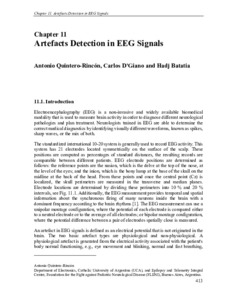Por favor, use este identificador para citar o enlazar este ítem:
https://repositorio.uca.edu.ar/handle/123456789/13861| Campo DC | Valor | Lengua/Idioma |
|---|---|---|
| dc.contributor.author | Quintero-Rincón, Antonio | es |
| dc.contributor.author | D’Giano, Carlos | es |
| dc.contributor.author | Batatia, Hadj | es |
| dc.date.accessioned | 2022-04-22T13:26:34Z | - |
| dc.date.available | 2022-04-22T13:26:34Z | - |
| dc.date.issued | 2021 | - |
| dc.identifier.citation | Quintero-Rincón, A., D’Giano, C., Batatia, H. Artefacts Detection in EEG Signals [en línea]. En: Yurish, S. Y. Advances in signal processing : reviews book series, Vol.2. Barcelona : International Frequency Sensor Association Publishing, 2021 ISBN 978-84-09-28830-4. Disponible en: https://repositorio.uca.edu.ar/handle/123456789/13861 | es |
| dc.identifier.uri | https://repositorio.uca.edu.ar/handle/123456789/13861 | - |
| dc.description.abstract | Abstract: Electroencephalography (EEG) is a non-invasive and widely available biomedical modality that is used to measure brain activity in order to diagnose different neurological pathologies and plan treatment. Neurologists trained in EEG are able to determine the correct medical diagnostics by identifying visually different waveforms, known as spikes, sharp waves, or the mix of both. The standardized international 10-20 system is generally used to record EEG activity. This system has 21 electrodes located symmetrically on the surface of the scalp. These positions are computed as percentages of standard distances, the resulting records are comparable between different patients. EEG electrode positions are determined as follows: the reference points are the nasion, which is the delve at the top of the nose, at the level of the eyes; and the inion, which is the bony lump at the base of the skull on the midline at the back of the head. From these points and once the central point (Cz) is localized, the skull perimeters are measured in the transverse and median planes. Electrode locations are determined by dividing these perimeters into 10 % and 20 % intervals, see Fig. 11.1. Additionally, the EEG measurement provides temporal and spatial information about the synchronous firing of many neurons inside the brain with a dominant frequency according to the brain rhythms [1]. The EEG measurement can use a unipolar montage configuration, where the potential of each electrode is compared either to a neutral electrode or to the average of all electrodes; or bipolar montage configuration, where the potential difference between a pair of electrodes spatially close is measured. | es |
| dc.format | application/pdf | es |
| dc.language.iso | eng | es |
| dc.rights | Acceso abierto | * |
| dc.rights.uri | http://creativecommons.org/licenses/by-nc-sa/4.0/ | * |
| dc.source | Advances in signal processing : reviews book series, Vol.2. Barcelona : International Frequency Sensor Association Publishing, 2021 | es |
| dc.subject | ELECTROENCEFALOGRAFIA | es |
| dc.subject | ACTIVIDAD NEURONAL | es |
| dc.subject | ENFERMEDAD CEREBRAL | es |
| dc.subject | DIAGNOSTICO POR IMAGEN | es |
| dc.subject | BIOMEDICINA | es |
| dc.subject | ELECTROFISIOLOGIA | es |
| dc.title | Artefacts Detection in EEG Signals | es |
| dc.type | Parte de libro | es |
| uca.disciplina | INGENIERIA | es |
| uca.issnrd | 1 | es |
| uca.affiliation | Fil: Quintero-Rincón, Antonio. Pontificia Universidad Católica Argentina. Facultad de Ingeniería y Ciencias Agrarias. Departamento de Electrónica; Argentina | es |
| uca.affiliation | Fil: D’Giano, Carlos. FLENI. Fundación de Lucha contra las Enfermedades Neurológicas Pediátricas. Centro Integral de Epilepsia y Telemetría; Argentina | es |
| uca.affiliation | Fil: Batatia, Hadj. Heriot-Watt University, MACS School, Knowledge park, Dubai-Campus; Emiratos Árabes Unidos | es |
| uca.version | publishedVersion | es |
| item.languageiso639-1 | en | - |
| item.grantfulltext | open | - |
| item.fulltext | With Fulltext | - |
| crisitem.author.dept | Facultad de Ingeniería y Ciencias Agrarias | - |
| crisitem.author.parentorg | Pontificia Universidad Católica Argentina | - |
| Aparece en las colecciones: | Libros/partes de libro | |
Ficheros en este ítem:
| Fichero | Descripción | Tamaño | Formato | |
|---|---|---|---|---|
| artefacts-detection-eeg-signals.pdf | 2,2 MB | Adobe PDF |  Visualizar/Abrir |
Visualizaciones de página(s)
94
comprobado en 27-abr-2024
Descarga(s)
386
comprobado en 27-abr-2024
Google ScholarTM
Ver en Google Scholar
Este ítem está sujeto a una Licencia Creative Commons

